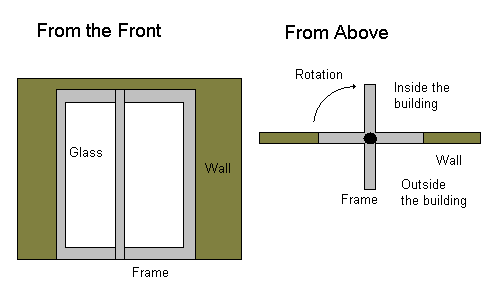Revolving door
A revolving door is a type of door that, as its name suggests, revolves in its frame.
Most kinds of doors are bolted to the wall and are on hinges. They open only one way, for a theoretical maximum of 180 degrees rotation. Sometimes hinge-doors can open both ways in their frames, for a theoretical maximum of 360 degrees rotation. A revolving door, however, has a theoretical rotation maximum of infinity, as it is set on a rotating shaft.

Around the shaft are several doors that are bolted to it and incapable of independent movement. The usual number of doors on a revolving door is four, although the number may be higher or lower. The doors may be electric (in which case there is a motor at the base of the shaft) or manual, in which case the doors have handle bars on them. When you push on the handlebar of the door in front of you, the entire shaft will rotate around.
Often there is a partial wall around the circumference of the revolving door with only openings sized to match an individual section of the revolving door. In this configuration, the revolving door prevents a direct path between the interior and exterior. This can be used as a partial airlock to minimize heat loss from the building. This can also be used as a security measure to allow only a single person through the revolving door at a time. This is in contrast to a normal door which suffers from easy "tailgating" by a second person when the door is opened for the authorized person.
History
H. Bockhacker of Berlin was granted German patent DE18349 on December 22, 1881 for "Thür ohne Luftzug" or "Door without draft of air".
Theophilus Van Kannel, of Philadelphia, was granted US patent 387,571 on August 7, 1888 for a "Storm-Door Structure". The patent drawings filed show a three partition revolving door. The patent describes it as having "three radiating and equidistant wings . . . provided with weather-strips or equivalent means to insure a snug fit". The door "possesses numerous advantages over a hinged-door structure . . .it is perfectly noiseless . . . effectually prevents the entrance of wind, snow, rain or dust . . ." "Moreover, the door cannot be blown open by the wind . . . there is no possibility of collision, and yet persons can pass both in and out at the same time." The patent further lists, "the excluding of noises of the street" as another advantage of the revolving door. It goes on to describe how a partition can be hinged so as to open to allow the passage of long objects through the revolving door. Of note, the patent itself does not use the term "revolving door", though it clearly is.
"In 1889, the Franklin Institute of Philadelphia (the original home of the revolving door) awarded the "John Scott Legacy Medal" to Van Kannel for his contribution to society."[1] "In 1899, the world’s first revolving door was installed at Rector’s, a restaurant on Times Square in Manhattan, located on Broadway between West 43rd and 44th Streets."[2]
References
- Alan Beadmore, The Revolving Door since 1881: Architecture in Detail, 2000, ISBN 9090137432
- Harvey E. Van Kannel and Joanne Fox Marshall, T. Van Kannel, the inventor : his autobiography and journal, 1988, Library of Congress control number 88091258
